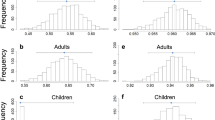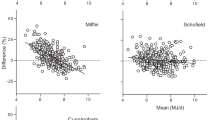Abstract
Whole-body daily energy expenditure is primarily due to resting energy expenditure (REE). Since there is a high inter-individual variance in REE, a quantitative and predictive framework is needed to normalize the data. Complementing the assessment of REE with data normalization makes individuals of different sizes, age, and sex comparable. REE is closely correlated with body mass suggesting its near constancy for a given mass and, thus, a linearity of this association. Since body mass and its metabolic active components are the major determinants of REE, they have been implemented into allometric modeling to normalize REE for quantitative differences in body weight and/or body composition. Up to now, various size and allometric scale laws are used to adjust REE for body mass. In addition, the impact of the anatomical and physical properties of individual body components on REE has been quantified in large populations and for different age groups. More than 80% of the inter-individual variance in REE is explained by FFM and its composition. There is evidence that the impact of individual organs on REE varies between age groups with a higher contribution of brain and visceral organs in children/adolescents compared with adults where skeletal muscle mass contribution is greater than in children/adolescents. However, explaining REE variations by FFM and its composition has its own limitations (inter-correlations of organs/tissues). In future, this could be overcome by re-describing the organ-to-organ variation using principal components analysis and then using the scores on the components as predictors in a multiple regression analysis.
This is a preview of subscription content, access via your institution
Access options
Subscribe to this journal
Receive 12 print issues and online access
$259.00 per year
only $21.58 per issue
Buy this article
- Purchase on Springer Link
- Instant access to full article PDF
Prices may be subject to local taxes which are calculated during checkout




Similar content being viewed by others
References
Müller MJ, Bosy-Westphal A, Klaus S, Kreymann G, Lührmann PM, Neuhäuser-Berthold M, et al. World Health Organization equations have shortcomings for predicting resting energy expenditure in persons from a modern, affluent population: generation of a new reference standard from a retrospective analysis of a German database of resting energy expenditure. Am J Clin Nutr. 2004;80:1379–90.
Heymsfield SB. Heat and life: the ongoing scientific odyssey. J Paren Enter Nutr. 2002;26:319–32.
Müller MJ, Langemann D, Gehrke I, Later W, Heller M, Glüer CC, et al. Effect of constitution on mass of individual organs and their association with metabolic rate in humans - a detailed view on allometric scaling. PLoS ONE. 2011;7:e22732.
Ravussin E, Bogardus C. Relationship of genetics, age, and physical fitness to daily energy expenditure and fuel utilization. Am J Clin Nutr. 1989;49:968–75.
Holliday MA, Potter D, Jarrah A, Bearg S. The relation of metabolic rate to body weight and organ size. Pediatr Res. 1967;1:185–95.
Gallagher D, Belmonte D, Deurenberg P, Wang Z, Krasnow N, Pi-Sunyer X, et al. Organ-tissue mass measurement allows modeling of REE and metabolically active tissue mass. Am J Physiol Endocrinol Metab. 1998;275:E249–58.
Illner K, Brinkmann G, Heller M, Bosy-Westphal A, Müller MJ. Metabolically active components of fat free mass and resting energy expenditure in non-obese adults. Am J Physiol Endocrinol Metab. 2000;278:E308–15.
Heymsfield SB, Thomas D, Bosy-Westphal A, Shen W, Petersen CM, Müller MJ. Evolving concepts on adjusting human resting energy ependiture measurements for body size. Obes Rev. 2012;13:1001–14.
Bosy-Westphal A, Reinecke U, Schlörke T, Illner K, Kutzner D, Heller M, et al. Effect of organ and tissue masses on resting energy expenditure in underweight, normal weight and obese adults. Int J Obes. 2004;28:72–9.
Later W, Bosy-Westphal A, Hitze B, Kossel E, Glüer CC, Heller M, et al. No evidence of mass dependency of specific metabolic rates in healthy humans. Am J Clin Nutr. 2008;88:1004–9.
Weibel ER. The pitfalls of power laws. Nature. 2002;417:131–2.
Rubner M. Die Gesetze des Energieverbrauchs bei der Ernährung. Leipzig: Franz Deuticke Verlag; 1902.
Kleiber M. The fire of life. An introduction to animal energetics. New York: John Wiley & Sons; 1961.
Bosy-Westphal A, Braun W, Schautz B, Müller MJ. Issues in characterizing energy expenditure in obesity and after weight loss. Front Physiol. 2013;4:47.
Geisler C, Braun W, Pourhassan M, Schweitzer L, Glüer CC, Bosy-Westphal A, et al. Gender-specific association in age-related changes in resting energy expenditure (REE) and MRI-mesasured body composition in healthy Caucasians. J Gerontol A Biol Sci Med Sci. 2015;94:1–6.
Kubera B, Bosy-Westphal A, Peters A, Braun W, Langemann D, Neugebohren S, et al. Energy allocation between brain and body during ontogenic development. Am J Hum Biol. 2013;25:725–32.
Frayn KN. Calculation of substrate oxidation rates in vivo from gaseous exchange. J Appl Physiol. 1983;55:628–34.
Weinsier RL, Schutz Y, Bracco D. Reexamination of the relationship of resting metabolic rate to fat-free mass and to the metabolically active components of fat-free mass in humans. Am J Clin Nutr. 1992;55:790–4.
Elia M. Organ and tissue contribution to metabolic rate. In: Kinney J, Tucker HN, editors. Energy metabolism: tissue determinants and cellular corrolaries. New York: Raven Press; 1992. p. 61–79.
Frayn KN, Lund P, Walker M. Interpretation of oxygen and carbon dioxide exchange across tissue beds in vivo. Clin Sci. 1993;85:373–84.
Müller MJ. Hepatic fuel selection. Proc Nutr Soc. 1995;54:139–50.
Müller MJ, Bosy-Westphal A, Kutzner D, Heller M. Metabolically active components of fat free mass and resting energy expenditure in humans: recent lessons from imaging technologies. Obes Rev. 2002;3:113–22.
Müller MJ, Wang Z, Heymsfield SB, Schautz B, Bosy-Westphal A. Advances in the understanding of specific metabolic rates of major organs and tissues in humans. Curr Opin Clin Nutr Metab Care. 2013;16:501–8.
Wang Z, Ying Z, Bosy-Westphal A, Zhnag J, Heller M, Later W, et al. Evaluation of specific metabolic rates of major organs and tissues: comparison between men and women. Am J Hum Biol. 2011;23:333–8.
Wang Z, Ying Z, Bosy-Westphal A, Zhang J, Schautz B, Later W, et al. Specific metabolic rates of major organs and tissues across adulthood: evaluation of a mechanistic model of resting energy expenditure. Am J Clin Nutr. 2010;92:1369–77.
Bouchard C, Deriaz O, Perusse L, Tremblay A. Genetics of energy expenditure in humans. In: Bouchard C, editor. The genetics of obesity. Boca Raton: CRC Press; 1994; p. 135–45.
Bosy-Westphal A, Wolf A, Bührens F, Hitze B, Czech N, Mönig H, et al. Familial influences and obesity-associated metabolic risk factors contribute to the variation in resting energy expenditure: the Kiel Obesity Prevention Study. Am J Clin Nutr. 2008;87:1695–701.
Bosy-Westphal A, Onur S, Wolf A, Korth O, Pfeuffer M, Schrezenmeir J, et al. Common familial influences on clustering of metabolic syndrome traits with central obesity and insulin resistance: the Kiel Obesity Prevention Study. Int J Obes. 2007;31:784–90.
Jequier E, Acheson K, Schutz Y. Assessment of energy expenditure and fuel utilization in man. Annu Rev Nutr. 1987;7:187–208.
Bader N, Bosy-Westphal A, Dilba B, Müller MJ. Intra- and interindividual variability of resting energy expenditure in healthy male subjects - biological and methodological variability of resting energy expenditure. Br J Nutr. 2005;94:843–9.
Prado CMM, Heymsfield SB. Lean tissue imaging: a new era for nutritional assessment and intervention. J Paren Enter Nutr. 2014;38:940–53.
Müller MJ, Braun W, Pourhassan M, Geisler C, Bosy-Westphal A. Application of standards and models in body composition analysis. Proc Nutr Soc. 2016;75:181–7.
Schadewaldt P, Nowottny B, Straßburger K, Kotzka J, Roden M. Indirect calorimetry in humans: a postcalorimetric evaluation procedure for correction of metabolic monitor variability. Am J Clin Nutr. 2013;97:763–73.
Watson LPE, Raymond-Barker P, Moran C, Schoenmakers N, Mitchell C, Bluck L, et al. An approach to quantifying abnormalities in energy expenditure and lean mass in metabolic diseases. Eur J Clin Nutr. 2014;68:234–40.
Author information
Authors and Affiliations
Corresponding author
Ethics declarations
Conflict of interest
The authors declare that they have no conflict of interest.
Rights and permissions
About this article
Cite this article
Müller, M.J., Geisler, C., Hübers, M. et al. Normalizing resting energy expenditure across the life course in humans: challenges and hopes. Eur J Clin Nutr 72, 628–637 (2018). https://doi.org/10.1038/s41430-018-0151-9
Received:
Revised:
Accepted:
Published:
Issue Date:
DOI: https://doi.org/10.1038/s41430-018-0151-9
This article is cited by
-
Association of resting energy expenditure with phase angle in hospitalized older patients: a cross-sectional analysis
European Journal of Clinical Nutrition (2024)
-
Being a scientist
European Journal of Clinical Nutrition (2023)
-
The scaling of human basal and resting metabolic rates
European Journal of Applied Physiology (2021)
-
Time-restricted eating effects on performance, immune function, and body composition in elite cyclists: a randomized controlled trial
Journal of the International Society of Sports Nutrition (2020)
-
Population Diversity Challenge the External Validity of the European Randomized Controlled Trials Comparing Laparoscopic Gastric Bypass and Sleeve Gastrectomy
Obesity Surgery (2020)



